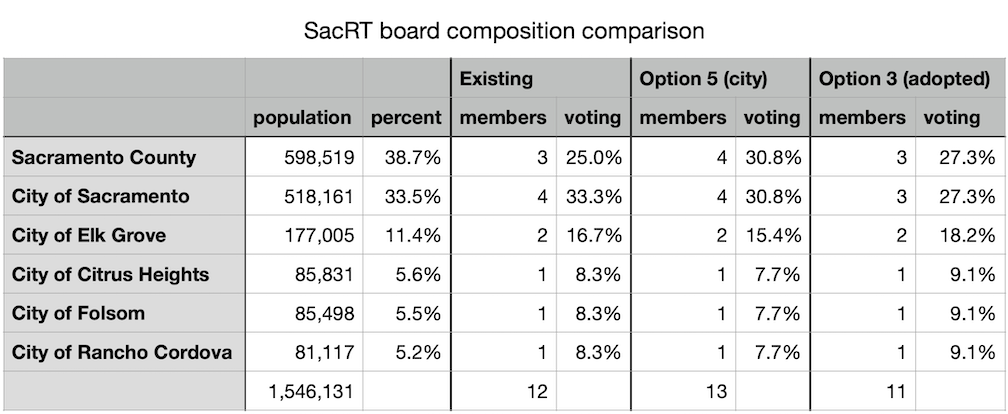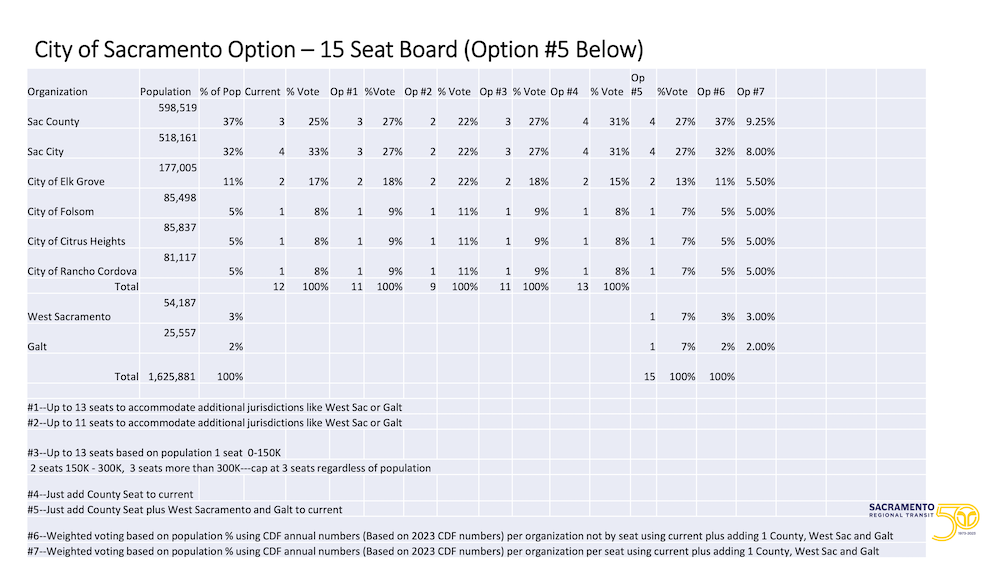Note: The table below, showing board members and voting percentage compared to population, was updated to include the City of Sacramento proposal by board member Rick Jennings, option 5. Though this proposal was described in the text, it was not included in the table. The city proposal chart, included in the board agenda item, is also included, at the bottom of the post.
At the February 26, 2024, SacRT Board of Directors meeting, the board voted to reduce the voting power of the City of Sacramento and Sacramento County. There were three options before the board, each representing a weakness in the current one-member one-vote model of board composition and governance.
The option that carried reduces the City of Sacramento board members from 4 to 3 and holds all of the others the same. The effect of this is to reduce the voting power of City of Sacramento and the county, and to increase the power of the small cities in the SacRT service area. All of the small cities voted to increase their power. Phil Serna spoke for and voted to maintain a roughly population-weighted board membership, as did three of the City of Sacramento members. For some reason, Lisa Kaplan, of the city, abstained. The two other Sacramento County members, Patrick Kennedy and Pat Hume, voted to reduce the county’s representation, for unknown reasons. The motion that passed, to be forwarded to Assemblymember Stephanie Nguyen for legislation to implement in Public Utilities Commission (PUC) code, has 3 members each for the City of Sacramento and Sacramento County, 2 for City of Elk Grove, and 1 each for cities of Citrus Heights, Folsom, and Rancho Cordova.
The table below shows the percentage of the population in the SacRT service area, the existing members and voting percentage, and the new members and voting percentage if the change is made. This was adapted from the table provided by board member Rick Jennings on behalf of the city. As you can see, the voting power of the City of Sacramento and Sacramento County is considerably reduced below a population-weighted number, while the voting power of the small cities is considerably increased. STAR believes that this imbalance in power will lead to poor board decisions and a weaker SacRT.

The discussions of a cap on the total board membership, and representation for potential future members Galt and West Sacramento, are red herrings, intended to divert attention away from the basic question of voting representation. Nothing in state law provides that board membership must be capped, nor is there anything in PUC code related to SacRT that requires it be capped. If Galt and West Sacramento were to join, the voting power of the City of Sacramento and Sacramento County would be further diluted, with an even more prominent shift in power to the smaller cities.
It has long been the position of STAR that a population-weighted voting model is the only acceptable governance model for SacRT. It is the people, not the governments, that should be represented. The more SacRT depends on the one-member one-vote model, the further from representation of the citizens, and democracy, the agency becomes. STAR supported the addition of a member for Elk Grove last year, in the interest of fairness for their larger population, but did not expect that those members would then vote to reduce the voting power of the City of Sacramento and Sacramento County.
The decision of the SacRT Board on board composition is WRONG. We will be communicating with Assemblymember Stephanie Nguyen about our position.
